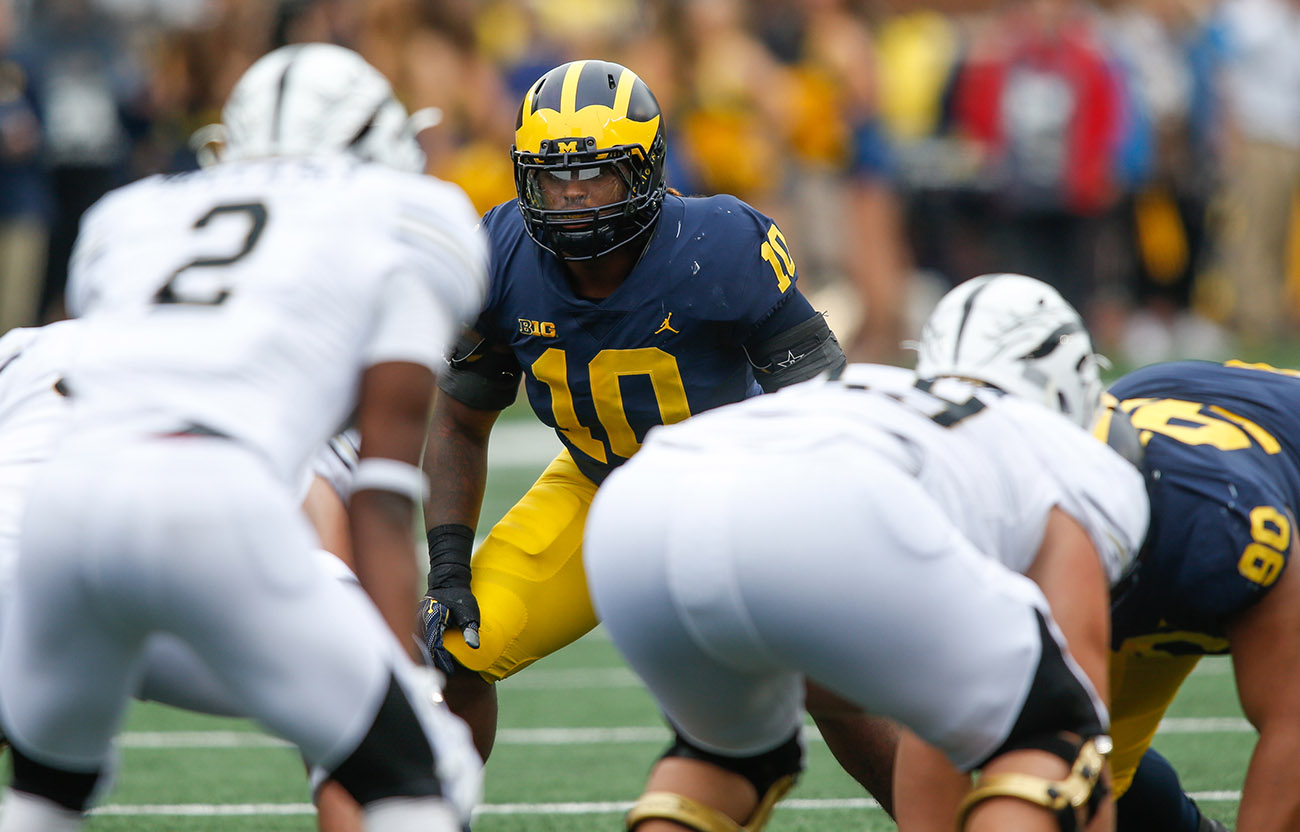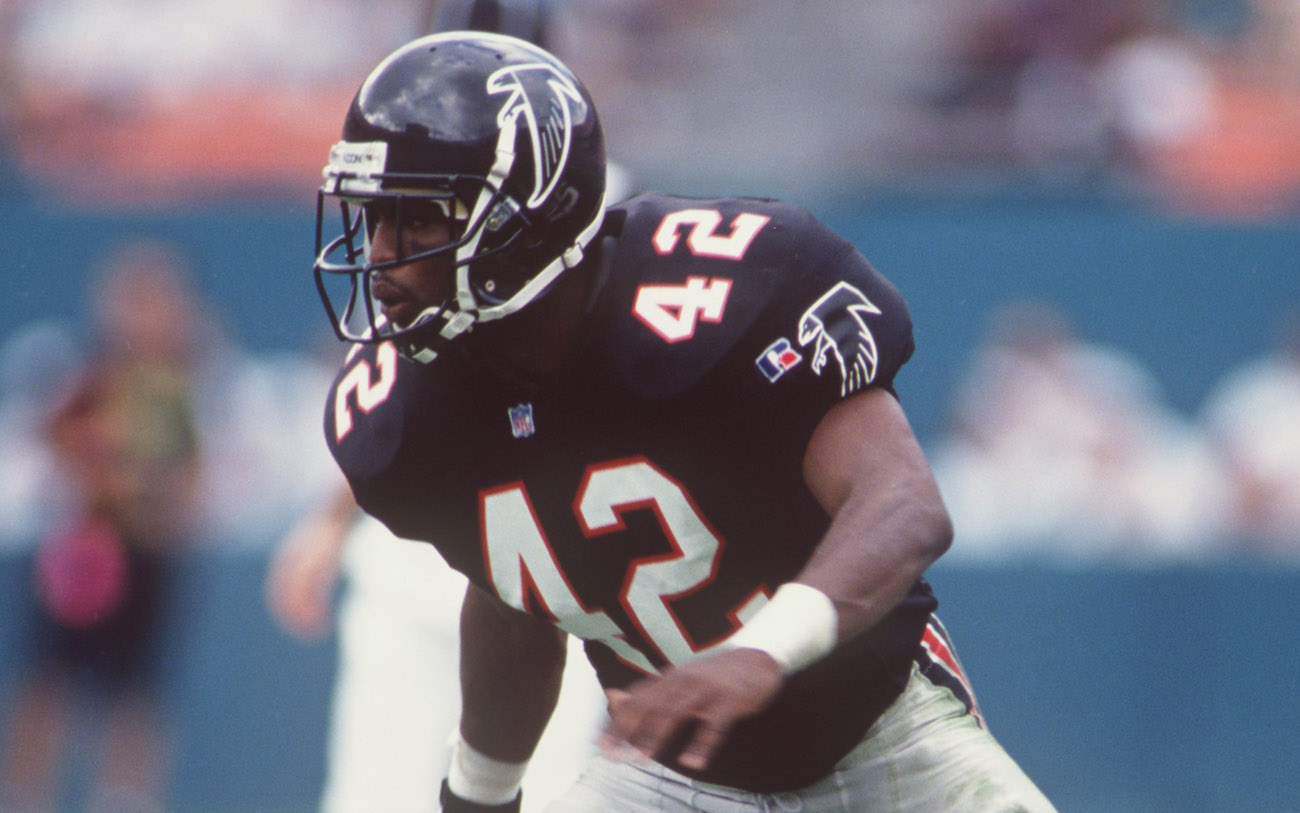Devin Bush Is Uniquely Built for the Modern NFL

When Devin Bush Sr. was drafted 24 years ago, a scout from the Dallas Cowboys joined him in his living room. This was 1995, the biggest need on the Cowboys’ roster was safety, and they were so confident they’d get the Florida State product with the 28th pick that they flew a scout out to Florida so he could take Bush back to Dallas with him.
At pick No. 26 in the first round, Bush’s phone rang. Watch the television, the voice on the other end told him, your name is about to appear. It was the Atlanta Falcons calling—two slots before Dallas would be on the clock.
The Cowboys scout released a four-letter expletive beginning with the letter “F” and left Bush’s home shortly thereafter—the scout did congratulate him and offer his well wishes first. Thus began Bush’s NFL career, in Atlanta and not in Dallas. (Dallas, by the way, ended up trading back twice from pick No. 28 once they lost out on their guy and selected running back Sherman Williams in the second round).
Bush Sr. told this story on the eve of this year’s draft, knowing his 20-year-old son now appreciated the uncertainty of the pre-draft process—and also knowing that his son's experience would be quite a bit different. Devin Bush Jr. would walk a red carpet; wear a black-and-white ensemble (“not a suit suit,” he said) that became the fashion talk of the evening; and wait in a green room until he could walk across stage in front of thousands of people lining Nashville’s main drag, culminating with him holding up a jersey of the team that had drafted him.
There’s another difference between father and son: the position they play. Bush Jr. weighs more than his father did when he played, but they’re the same height (5' 11"), both ran the 40-yard dash in the 4.4-second range and had similar vertical jumps and 225-pound bench presses (though Bush Sr. claims he recorded two more reps). And in today’s NFL, Bush Jr. can play inside linebacker.
The selections of LSU’s Devin White by the Buccaneers at No. 5, and Bush Jr. at No. 10 by the Steelers—who so loved him they uncharacteristically gave up two draft picks to trade up 10 spots—represent the defensive response to how offenses are changing.
“Me and him,” Bush Jr. says, referring to himself and White, “are kind of like two charms of the new style of football.”
He uses the word “charm” to mean that they are defensive pieces that can be mixed and matched all over the field. This year's draft was the first time this century that two off-ball linebackers were selected in the top 10, and it didn’t just have to do with the fact that both are individually exceptional players. They also fit a role that’s becoming increasingly important with the rise of spread, college-style offenses through the NFL: three-down linebackers who have the speed and athleticism to never have to come off the field.
Both Bush and White are on the smaller side—6-feet or under, sub-240 pounds—but the long-held views on prototypical size at several positions is shifting (see: 5' 10" QB Kyler Murray drafted No. 1 overall). Bush and White are fast enough to run with anyone on the field, and that’s the trait that matters most.
“I feel like if you’re a three-down linebacker, then you deserve to go as high as possible,” White says. “Especially if you’re a good three-down linebacker. The game is speeding up, and backs are not just like downhill backs. They’re backs like Alvin Kamara, [who] you can put at receiver, and you’ve gotta have somebody to go cover them. You don’t want to keep putting safeties on the field, because what if they motion them back in, [and] now you have to put that safety in the box. So, it’s fitting.”

Being undersized is a part of Bush’s identity, to the degree that he has developed an UNDRSZD logo that he had printed on T-shirts as well as the lining of his non-suit suit on draft night. But in talking with NFL teams about Bush and White before the draft, their size wasn’t a major talking point—rather, evaluators loved their speed and “coverability,” scout jargon to mean that they can, well, cover in the passing game. In Bush’s case, his instincts stood out—i.e., his ability to understand and anticipate what would happen on each play, contributing to his 80 tackles, five sacks and six PBUs in his last season at Michigan, when he was named the Big Ten Defensive Player of the Year.
Bush has prepared himself for the job he’s about to have, an anchor in the middle of the Steelers defense, ever since he told his dad he wanted to play football at age 6. Bush Sr. responded by pulling out his old helmets, the ones he’d worn during his eight-year NFL playing career for the Falcons, Rams and Browns. They each put one on, buckled the chinstraps, and the former NFL safety knocked his young son over. He did it a few times, Devin Jr. popping back up again and again, the father asking his son if he was O.K., testing that he could withstand the physicality of the sport.
Bush Sr. coached his son at every level: from little league football, to winning a Florida state championship at Flanagan High School in Broward County, to being hired to Jim Harbaugh’s Michigan staff as a defensive analyst after his son signed his scholarship to play there. When Bush was thinking about turning pro after his junior season—like his dad had also done—Bush Sr. assured him that yes, he could play in the NFL. But before that moment was a decade-and-a-half of coaching filled with moments the father designed to make his son feel uncomfortable. “I tried to make it as hard as possible,” Bush Sr. says, “so nobody would never break him.”
Like when Bush Jr. was 10 years old and he asked his dad, why is everybody faster than me? His dad’s reply: “You suck. Find a way to catch up to them.” Bush Jr. tried everything he could, forcing himself to sprint even when he was just playing around outside, but eventually, his junior year of high school, his genetics kicked in, too. When Bush Sr. watched his son’s press conference the day before he worked out at the NFL combine and heard him say, “I don’t feel pressure,” he felt great pride. The uncomfortable lessons he’d given his son had paid off for one of the biggest moments of his life (the next day, Bush ran one of the fastest 40-yard dash times ever clocked for a linebacker at the combine, 4.43 seconds).

Bush began studying film in high school, understanding that as he climbed the ranks in football he needed to find ways to win in situations when he would not be the biggest, fastest or strongest. “Film will show you that,” he explains. He tried to home in on opposing players’ movements, looking for clues on whether they were about to speed up, slow down or throw a stiff arm. He also focused on ways to use his size to his advantage. When covering receivers or tight ends who are taller than him, he reasons that it’s easier to get up under his opponent, who will have a harder time pushing him off. When he does face a bigger running back, his mindset is that there’s simply a bigger target to aim for when he tackles, plus the back won’t be able to escape from him—though much of playing defense nowadays is matching up with players like the Saints’ Kamara.
“With everything that comes with the game now, the game is definitely not, Get in big packages and run power football all day,” Bush says. “The league is getting a lot of playmakers, and they want to put them all in space to create matchups. Me and Devin White are great matchups with running backs or faster guys that a lot of these bigger linebackers, 6' 2" or 6' 3", 250 pounds, can’t really keep up with. We are two unique players, and [we] don't come around very often.”
Despite his confidence, Bush low-balled his draft stock. The day before his name was called, he was preparing himself to go as late as pick No. 31. But the Steelers knew he wouldn’t be around even at No. 20, so they sacrificed a second-round pick this year and a third-rounder in 2020 to make sure they got their guy to step into the role Ryan Shazier once played. The benefit of Bush Sr. having a Cowboys scout sitting in his living room on draft night was that he knew he’d go no later than Dallas’s first-round spot. Bush Sr. reminded his son: “The worst thing that’s going to happen to you is that you’re drafted.” Still, they couldn’t help but comb mock drafts and ask for opinions on how things might shake out, similar to April 1995, when Bush Sr. was quoted in a Miami Herald article asking, “What do you hear?”
When Bush met with teams around the league, it was rare to find one where there wasn’t someone who, as he put it, “knew about my dad, or played with him, or tried to draft him.” Tampa Bay’s special teams coordinator, Keith Armstrong, for example, was the safeties coach for the Falcons in 1995. He was in attendance at a workout Bush Sr. did for three teams the week of the draft at the Dolphins facility; a few days later, Armstrong was greeting him in Atlanta. During Bush’s visit to the Buccaneers, Armstrong told him old stories about how he used to pick on his dad when he was a rookie. And ESPN commentator Louis Riddick, Bush Sr.’s teammate in Atlanta, deemed Bush “pound for pound, the best player in this draft” in a pre-draft interview on the Dan Patrick Show.
Bush, however, has always been intent on forging his own path, dating back to when he turned down his dad’s alma mater, Florida State, to play at Michigan. Now, in Pittsburgh, he hopes to continue defining not just his own name, but also how you think about the linebacker position.
“Devin Bush is coming,” he said on draft night, “and you guys are going to have a lot to watch.”
• Question or comment? Email us at talkback@themmqb.com.
